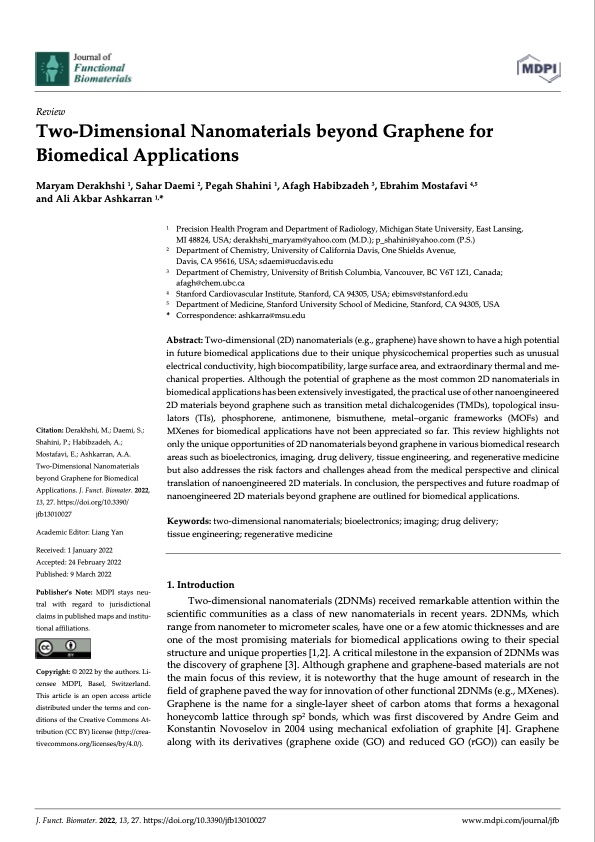
PDF Publication Title:
Text from PDF Page: 001
Review Two-Dimensional Nanomaterials beyond Graphene for Biomedical Applications Maryam Derakhshi 1, Sahar Daemi 2, Pegah Shahini 1, Afagh Habibzadeh 3, Ebrahim Mostafavi 4,5 and Ali Akbar Ashkarran 1,* Citation: Derakhshi, M.; Daemi, S.; Shahini, P.; Habibzadeh, A.; Mostafavi, E.; Ashkarran, A.A. Two-Dimensional Nanomaterials beyond Graphene for Biomedical Applications. J. Funct. Biomater. 2022, 13, 27. https://doi.org/10.3390/ jfb13010027 Academic Editor: Liang Yan Received: 1 January 2022 Accepted: 24 February 2022 Published: 9 March 2022 Publisher’s Note: MDPI stays neu- tral with regard to jurisdictional claims in published maps and institu- tional affiliations. Copyright: © 2022 by the authors. Li- censee MDPI, Basel, Switzerland. This article is an open access article distributed under the terms and con- ditions of the Creative Commons At- tribution (CC BY) license (http://crea- tivecommons.org/licenses/by/4.0/). 1 Precision Health Program and Department of Radiology, Michigan State University, East Lansing, MI 48824, USA; derakhshi_maryam@yahoo.com (M.D.); p_shahini@yahoo.com (P.S.) 2 Department of Chemistry, University of California Davis, One Shields Avenue, Davis, CA 95616, USA; sdaemi@ucdavis.edu 3 Department of Chemistry, University of British Columbia, Vancouver, BC V6T 1Z1, Canada; afagh@chem.ubc.ca 4 Stanford Cardiovascular Institute, Stanford, CA 94305, USA; ebimsv@stanford.edu 5 Department of Medicine, Stanford University School of Medicine, Stanford, CA 94305, USA * Correspondence: ashkarra@msu.edu Abstract: Two-dimensional (2D) nanomaterials (e.g., graphene) have shown to have a high potential in future biomedical applications due to their unique physicochemical properties such as unusual electrical conductivity, high biocompatibility, large surface area, and extraordinary thermal and me- chanical properties. Although the potential of graphene as the most common 2D nanomaterials in biomedical applications has been extensively investigated, the practical use of other nanoengineered 2D materials beyond graphene such as transition metal dichalcogenides (TMDs), topological insu- lators (TIs), phosphorene, antimonene, bismuthene, metal–organic frameworks (MOFs) and MXenes for biomedical applications have not been appreciated so far. This review highlights not only the unique opportunities of 2D nanomaterials beyond graphene in various biomedical research areas such as bioelectronics, imaging, drug delivery, tissue engineering, and regenerative medicine but also addresses the risk factors and challenges ahead from the medical perspective and clinical translation of nanoengineered 2D materials. In conclusion, the perspectives and future roadmap of nanoengineered 2D materials beyond graphene are outlined for biomedical applications. Keywords: two-dimensional nanomaterials; bioelectronics; imaging; drug delivery; tissue engineering; regenerative medicine 1. Introduction Two-dimensional nanomaterials (2DNMs) received remarkable attention within the scientific communities as a class of new nanomaterials in recent years. 2DNMs, which range from nanometer to micrometer scales, have one or a few atomic thicknesses and are one of the most promising materials for biomedical applications owing to their special structure and unique properties [1,2]. A critical milestone in the expansion of 2DNMs was the discovery of graphene [3]. Although graphene and graphene-based materials are not the main focus of this review, it is noteworthy that the huge amount of research in the field of graphene paved the way for innovation of other functional 2DNMs (e.g., MXenes). Graphene is the name for a single-layer sheet of carbon atoms that forms a hexagonal honeycomb lattice through sp2 bonds, which was first discovered by Andre Geim and Konstantin Novoselov in 2004 using mechanical exfoliation of graphite [4]. Graphene along with its derivatives (graphene oxide (GO) and reduced GO (rGO)) can easily be J. Funct. Biomater. 2022, 13, 27. https://doi.org/10.3390/jfb13010027 www.mdpi.com/journal/jfbPDF Image | Nanomaterials beyond Graphene for Biomedical Applications

PDF Search Title:
Nanomaterials beyond Graphene for Biomedical ApplicationsOriginal File Name Searched:
jfb-13-00027.pdfDIY PDF Search: Google It | Yahoo | Bing
Salgenx Redox Flow Battery Technology: Salt water flow battery technology with low cost and great energy density that can be used for power storage and thermal storage. Let us de-risk your production using our license. Our aqueous flow battery is less cost than Tesla Megapack and available faster. Redox flow battery. No membrane needed like with Vanadium, or Bromine. Salgenx flow battery
| CONTACT TEL: 608-238-6001 Email: greg@salgenx.com | RSS | AMP |